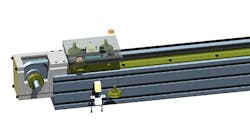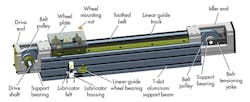This file type includes high-resolution graphics and schematics when applicable.
A linear actuator is a combination of linear guides and power-transmission components contained in an assembly. Sometimes these are referred to as a linear motion system, or an actuated system. Designing with a complete actuated linear system can reduce overall machine design and fabrication costs. Standardized actuator products eliminate the effort associated with integrating lower-level components and assemblies, and they contain application-tested and -optimized construction.
The LoPro Linear Actuator product line from Bishop-Wisecarver Corp. is an industry-tested solution for accelerating motion-system design. LoPro actuators are made from standardized sub-assemblies and options that are customized for specific application requirements.
They utilize DualVee Motion Technology for the linear guides, which are double-row angular contact ball-bearing guide wheels that provide smooth and quiet motion over long length. The guide wheels feature 90-degree surfaces that roll on long linear tracks. The tracks can be up to 20 feet long and butt-joined for unlimited lengths. LoPro actuators are produced in user-specified stroke lengths, and motion systems in the 15-meter range are common for long-distance pick-and-place applications.
Several drive types are available, including ball screw, lead screw, AT belt, and ANSI roller chain. Power transmission via an AT-style belt provides for a good balance of precision locating accuracy, long travel stroke lengths, and high speed. The AT belt is a high durometer polyurethane belt with internal steel-cable reinforcement. LoPro linear actuators with belt drives include a complete system to support and tension the belt.
The drive end is where a motor or manual hand wheel is attached to a keyed output shaft. The shaft is held with support bearings and holds a toothed pulley. The idler end also contains a toothed pulley and support bearings, but also includes a yoke to apply belt tension. The belt is attached to a wheel plate that includes the linear-guide wheel bearings. Motion is generated at the wheel plate when the drive shaft is rotated.
Looking for parts? Go to SourceESB.


